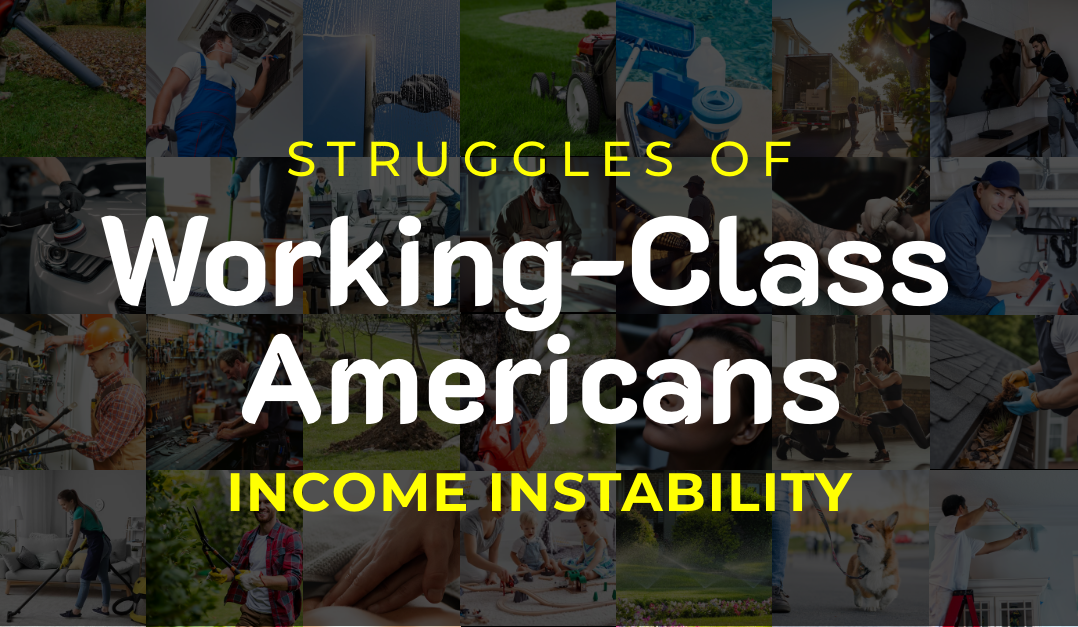Struggles of Working-Class Americans:
Deep Dive into Income Instability
In recent years, income instability has emerged as a significant issue affecting working-class Americans. As the economy evolves and more individuals turn to gig work and freelance opportunities, the traditional notions of job security and consistent pay have been challenged. This article explores the pervasive issue of income instability among working-class Americans, citing recent statistics to highlight the scope and impact of this economic phenomenon.
Prevalence of Income Instability
Income volatility is a common experience for many American households. According to a study by the Federal Reserve, 40% of American households reported experiencing volatile monthly incomes in 2019. This volatility is characterized by unpredictable spikes and drops in income, making financial planning a daunting task. The JPMorgan Chase Institute further reports that 55% of individuals face month-to-month income fluctuations of more than 30%, underscoring the widespread nature of this issue.
The Gig Economy’s Role
The rise of the gig economy has significantly contributed to income instability. The Pew Research Center found that approximately 16% of Americans have earned money from online gig platforms at some point. Among these gig workers, 29% state that this income is essential for meeting basic needs. However, the Edison Research and Marketplace survey revealed that 44% of gig workers experience varying income from month to month, highlighting the instability inherent in gig work.
Financial Well-Being and Savings Challenges
Income instability has a profound impact on financial well-being. The Aspen Institute reports that 60% of gig workers struggle to save due to their unpredictable earnings. Additionally, the Urban Institute found that households experiencing income volatility are more likely to face financial hardship, with 57% of these households unable to cover a $400 emergency expense. This lack of financial resilience makes it difficult for many working-class Americans to achieve long-term financial stability.
Demographic Disparities
Income volatility does not affect all demographics equally. The Economic Policy Institute indicates that low-income families and minorities are disproportionately affected. African American and Hispanic families experience higher rates of income volatility compared to their white counterparts. The U.S. Financial Health Pulse 2020 Trends Report by the Financial Health Network shows that 54% of Black households and 49% of Hispanic households report income volatility, compared to 37% of white households. This disparity highlights the need for targeted policies to support the most vulnerable populations.
Employment Trends and Job Security of the Working-Class
Certain industries are more prone to income instability. Workers in construction, retail, and food services often face irregular hours and seasonal work, leading to inconsistent earnings. A 2018 survey by Prudential found that 44% of gig workers report not having consistent income from month to month, compared to 18% of traditional full-time workers. The Brookings Institution emphasizes that the nature of these jobs inherently leads to financial instability for workers.
Psychological and Social Impact
The psychological toll of income instability is significant. The Federal Reserve’s Report on the Economic Well-Being of U.S. Households found that individuals with volatile incomes report higher levels of financial stress and anxiety. The Center for Financial Services Innovation (CFSI) notes that 70% of Americans experiencing income volatility feel stressed about their finances, impacting their mental health and overall quality of life.
Housing and Food Insecurity
Income volatility also contributes to housing and food insecurity. The Urban Institute reports that 34% of households with income volatility struggle to pay rent or mortgage, leading to housing instability. Furthermore, the U.S. Department of Agriculture (USDA) indicates that households with unpredictable incomes have higher rates of food insecurity, affecting their health and well-being.
Retirement and Long-Term Financial Planning
The impact of income instability extends to retirement savings. A Bankrate survey found that 21% of Americans have no emergency savings, largely due to income volatility. The National Institute on Retirement Security reports that inconsistent earnings hinder many workers’ ability to contribute regularly to retirement accounts, jeopardizing their financial security in later years.
Conclusion
Income instability remains a pressing issue for working-class Americans, particularly those engaged in gig work and freelance jobs. The statistics highlight the extensive impact of this instability on financial well-being, mental health, housing security, and long-term financial planning. Addressing this issue requires comprehensive policies and support systems that provide financial stability and resilience for the most affected populations. By acknowledging and addressing the challenges of income volatility, we can work towards a more secure and equitable economic future for all working-class Americans.
How RateCard app features can help ›
All Blog Articles ›


0 Comments